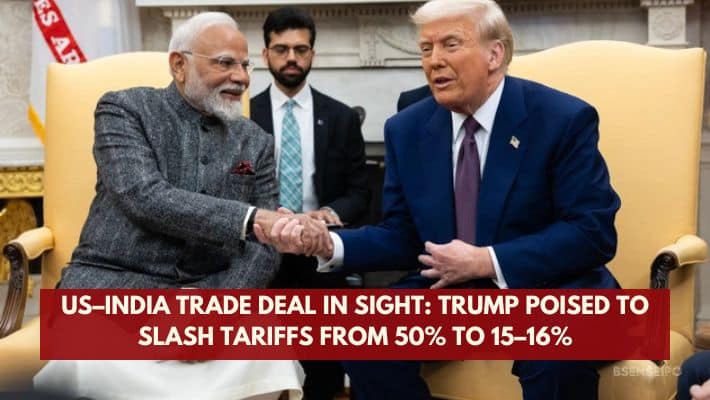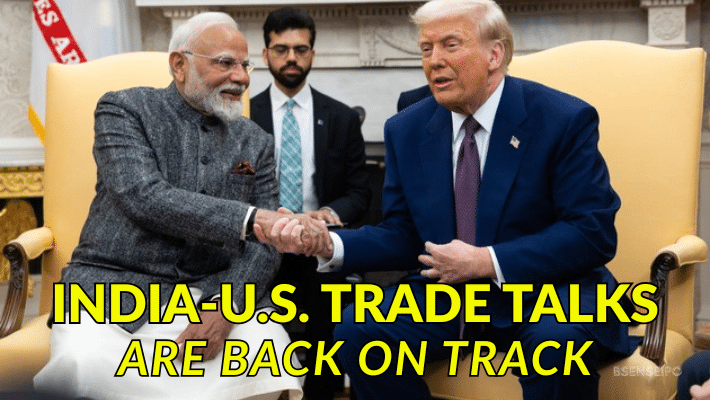US–India Trade Deal in Sight: Trump Poised to Slash Tariffs from 50% to 15–16%
US-India Trade Deal: A historic trade agreement between the United States and India may soon transform bilateral commerce. According to multiple reports, the Trump administration is considering cutting tariffs on Indian exports to the US from nearly 50% to 15–16%, marking one of the most significant trade concessions in decades. The deal is reportedly linked to India’s willingness to reduce its Russian oil imports and open its agricultural market to select American farm products.
The move signals a strategic realignment aimed at strengthening US–India economic and political cooperation amid global trade shifts and geopolitical competition.
The Context: Trade Tensions and Realignment
For years, US–India trade relations have been marked by disputes over tariffs, data localization, and market access. The US has long sought greater access for its agriculture, energy, and defense sectors, while India has pushed for reduced duties on its exports like textiles, pharmaceuticals, and engineering goods.
Under President Donald Trump’s current policy revival, the White House appears ready to finalize a deal that could rebalance trade barriers, enhance supply chain cooperation, and limit India’s economic dependence on rival energy sources such as Russia and Iran.
As per a Reuters report, the tariff cut would represent a “comprehensive reset” of the US–India trade framework, potentially taking effect as early as mid-2026 if approved by Congress.
Deal Highlights
1. Tariff Reduction
- Current Tariffs: Around 40–50% on key Indian exports, including textiles, leather goods, jewelry, and engineering products.
- Proposed Tariffs: A significant drop to 15–16%, aligning India more closely with favored US trading partners such as South Korea and Vietnam.
- Impact: Indian exporters could see cost savings of up to 35%, boosting competitiveness in the American market.
2. Energy Clause: Reduced Russian Oil Imports
- India has reportedly agreed to reduce crude oil imports from Russia, currently making up around 35% of its supply.
- This move aligns with Washington’s broader effort to curb Russian energy influence and support Western-aligned trade networks.
3. Agriculture Market Access
- In return, India would allow limited imports of non-GM (non-genetically modified) US corn, soymeal, and dairy products, which were previously restricted.
- The aim is to ensure balanced benefits for both sides, creating new openings for US farmers while protecting Indian consumers and small producers.
4. Technology and Digital Cooperation
- The trade deal is expected to include frameworks on digital trade, AI research collaboration, and cybersecurity standards — part of a larger economic strategy between the two democracies.
- This could pave the way for joint ventures in semiconductor manufacturing, clean tech, and 5G infrastructure.
Economic Impact on India
The tariff reduction would have profound implications for India’s export sectors:
- Textiles & Apparel: Lower US import duties could significantly revive India’s garment exports, which have struggled against competition from Bangladesh and Vietnam.
- Jewelry & Precious Metals: Gold and diamond exporters may see improved US access with lower duties.
- Engineering Goods: The deal could help Indian firms compete in the American automotive and industrial equipment sectors.
- Pharmaceuticals: India’s generic drug exports might face simplified compliance and approval mechanisms, streamlining US market entry.
Overall, India could see an export growth surge of 8–10% annually once the deal is operational, according to early projections by trade analysts.
Political & Strategic Significance
The proposed agreement is not merely an economic arrangement — it’s a strategic realignment.
- For the United States, it strengthens its supply chain resilience and counters Chinese manufacturing dominance.
- For India, it enhances geopolitical leverage and diversifies trade away from Russia and the Middle East.
- Both nations aim to build a trusted economic corridor, anchored in defense, technology, and renewable energy cooperation.
The deal also comes ahead of the 2026 US presidential election, allowing Trump to showcase renewed American leadership in Asia.
Challenges Ahead
While optimism is high, several challenges remain:
- Domestic Lobby Resistance: US farm groups and unions may demand stricter safeguards for American workers.
- Agricultural Policy Conflicts: India’s food security laws and small farmer protections could complicate import commitments.
- Implementation Timeline: Even after signing, full tariff implementation could take 12–18 months due to legal and procedural clearances.
- Geopolitical Balancing: India must manage its relations with Russia while adhering to new import targets.
Expert Opinions
Trade analysts see the potential deal as a “milestone” in global commerce:
“This could be the most consequential trade liberalization between the US and India since the 1990s,” said Dr. R. Mukherjee, Senior Fellow at the Indian Council for Research on International Economic Relations (ICRIER).
“It demonstrates strategic trust and acknowledges India’s importance in the Western supply chain ecosystem.”
Meanwhile, US Chamber of Commerce experts argue that tariff rationalization will unlock billions in bilateral trade, benefiting both small and large enterprises.
Conclusion
The proposed US–India trade deal, featuring a dramatic tariff reduction from 50% to 15–16%, could redefine the economic partnership between the two largest democracies in the world. By aligning interests in energy, agriculture, and technology, the agreement reflects a shared vision for stability, growth, and resilience in a changing global order.
If executed effectively, this could mark the beginning of a new golden era in US–India trade relations — one built on mutual respect, strategic alignment, and economic opportunity.




